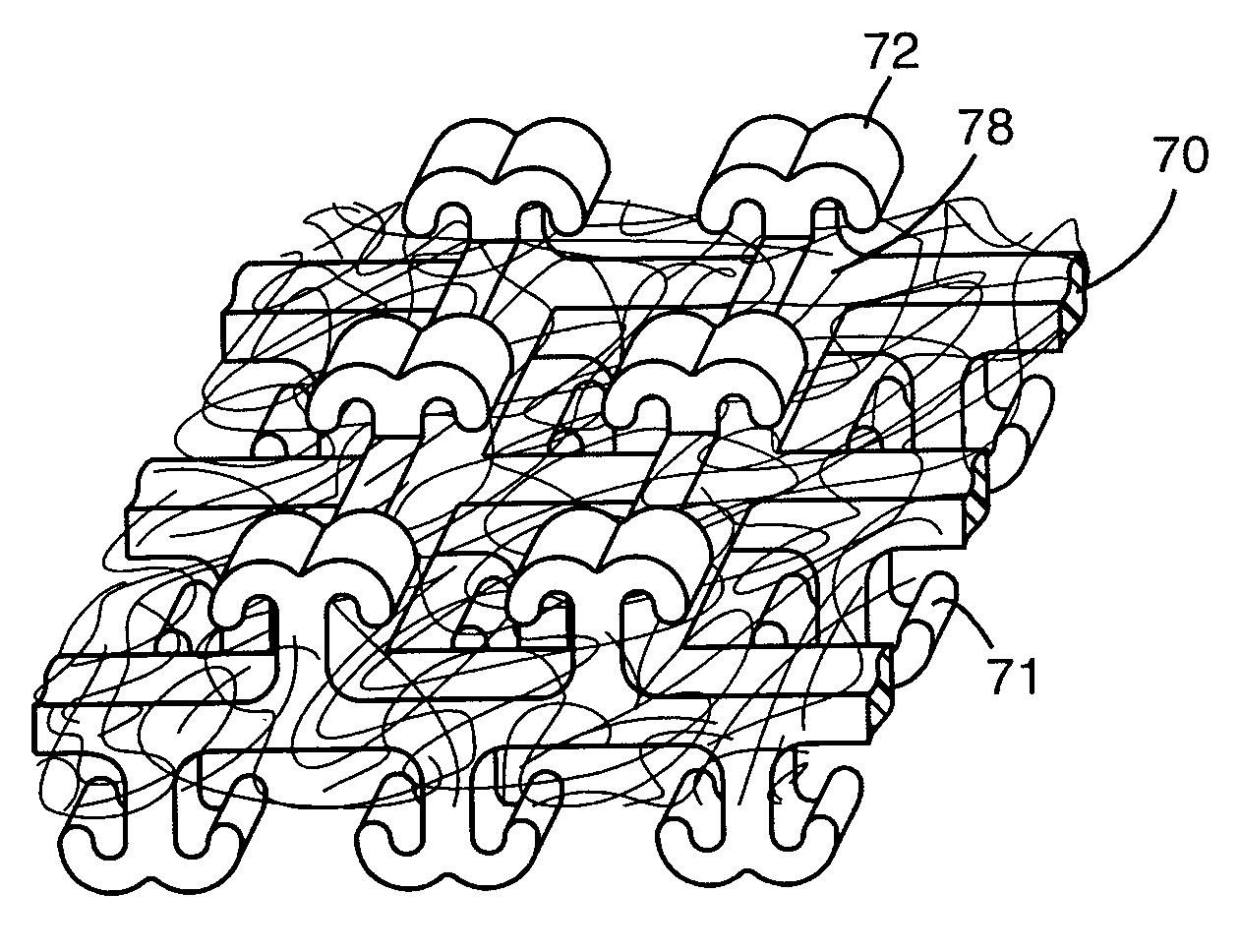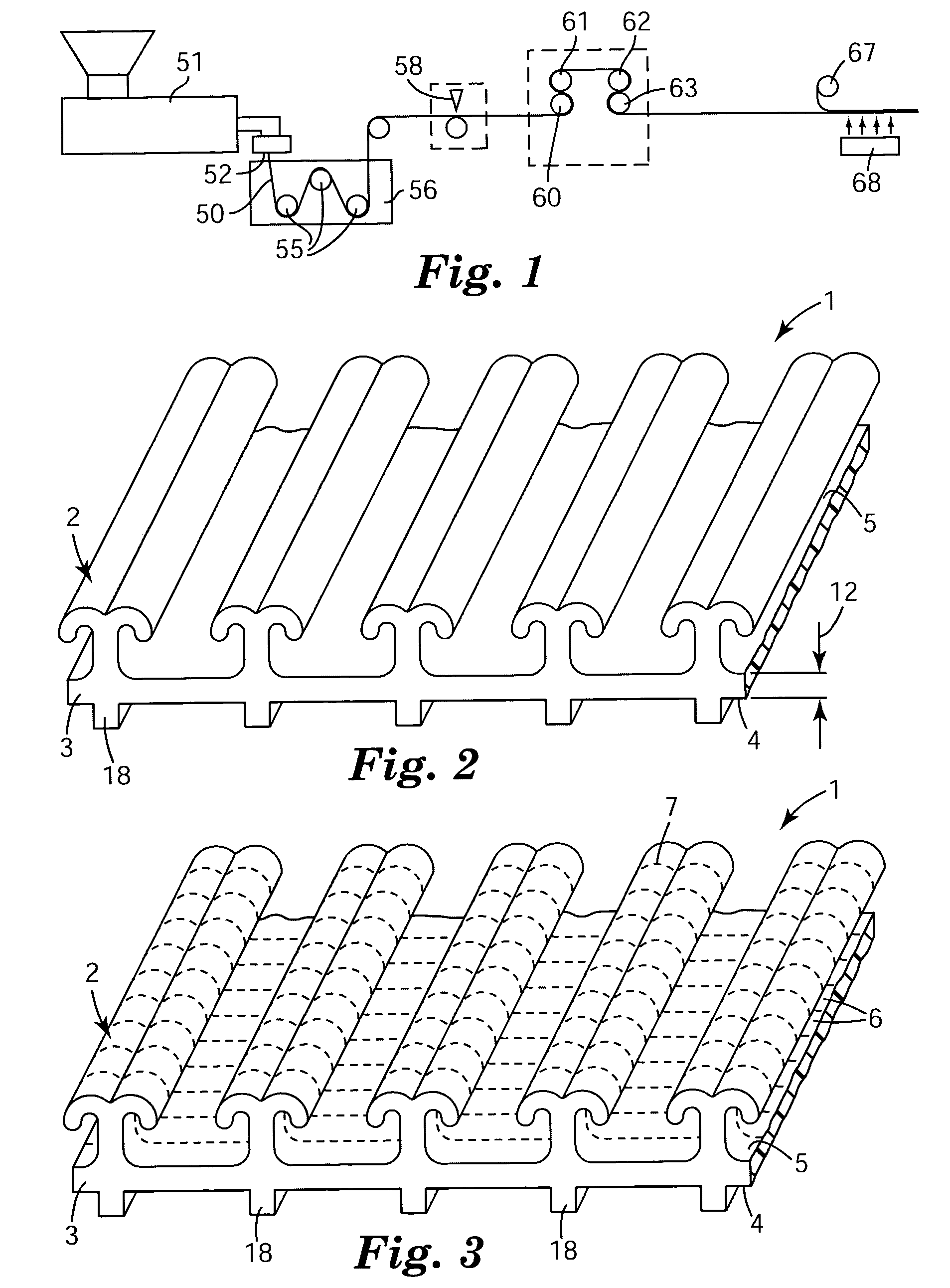Hook fastener and method of making
a technology of hooks and fasteners, applied in the field of meshes, netting or strand elements, can solve the problems of complex process of deposited hook material onto the web, requiring precision manufacturing, and generally non-uniform formed web material having the hook material, etc., to achieve uniform machine handling properties, low manufacturing cost, and simple manufacturing.
- Summary
- Abstract
- Description
- Claims
- Application Information
AI Technical Summary
Benefits of technology
Problems solved by technology
Method used
Image
Examples
example 1
[0049]A mesh hook netting was made using apparatus similar to that shown in FIG. 1. A polypropylene / polyethylene impact copolymer (SRC7-644, 1.5 MFI, Dow Chemical) was extruded with a 6.35 cm single screw extruder (24:1 L / D) using a barrel temperature profile of 175° C.-230° C.-230° C. and a die temperature of approximately 230° C. The extrudate was extruded vertically downward through a die having an opening cut by electron discharge machining to produce an extruded profiled web similar to that shown in FIG. 2. The crossweb spacing of the upper ribs was 7.3 ribs per cm. After being shaped by the die, the extrudate was quenched in a water tank at a speed of 6.1 meter / min with the water being maintained at approximately 10° C. The web was then advanced through a cutting station where the upper ribs and the base layer (but not the lower ribs) were transversely cut at an angle of 23 degrees measured from the transverse direction of the web. The spacing of the cuts was 305 microns. Afte...
example 2
[0052]A hydroentangled composite web was made similar to that in Example 1 except the two nonwoven unbonded carded webs consisted of a blend of 95% Kosa T224 3d polyester fibers and 5% Kosa T254 2d polyester bicomponent fibers. The basis weight of the carded webs was 30 grams / meter2. The composite web had a cloth-like feel and appearance, and was very flexible and conformable.
example 3
[0053]A hydroentangled composite web having elastic properties was produced similar to the web in Example 1 except an additional elastomeric nonwoven web was used and a fibrillated hook material was used in place of the hook netting.
[0054]A hook web, available from 3M Company St. Paul, Minn. as KN-3425, was fibrillated using the following procedure. A 10 cm wide hook web was fed into a rotary cutting apparatus similar to that shown in FIG. 1 of U.S. Pat. No. 5,058,472. The apparatus consisted of intermeshing upper and lower steel rotary cutting rolls fitted with continuous cutting blades mounted around the periphery of the rolls. Spacers were used in between the blades to provide approximately 6 blades / cm in the lateral direction. The apparatus was operated manually with a hand crank to advance the hook web through the nip of the cutting apparatus at a nip pressure of approximately 70 kg / cm2 to introduce slits through the web in the down web direction. Due to the input web being thi...
PUM
| Property | Measurement | Unit |
|---|---|---|
| pressures | aaaaa | aaaaa |
| pressures | aaaaa | aaaaa |
| diameters | aaaaa | aaaaa |
Abstract
Description
Claims
Application Information
 Login to View More
Login to View More - R&D
- Intellectual Property
- Life Sciences
- Materials
- Tech Scout
- Unparalleled Data Quality
- Higher Quality Content
- 60% Fewer Hallucinations
Browse by: Latest US Patents, China's latest patents, Technical Efficacy Thesaurus, Application Domain, Technology Topic, Popular Technical Reports.
© 2025 PatSnap. All rights reserved.Legal|Privacy policy|Modern Slavery Act Transparency Statement|Sitemap|About US| Contact US: help@patsnap.com



